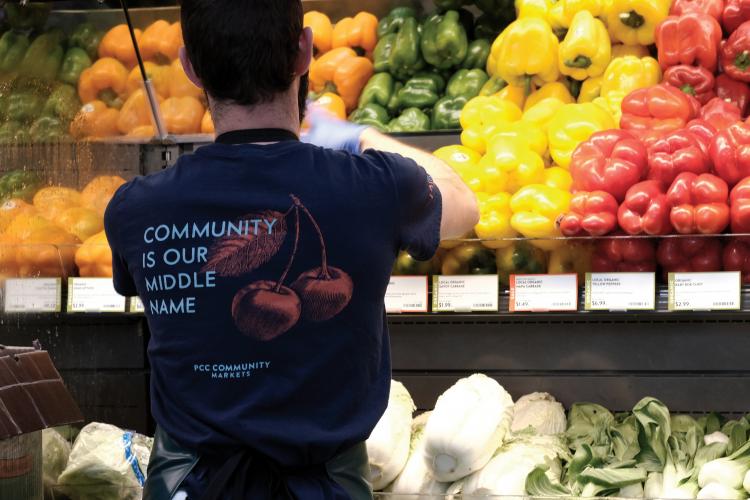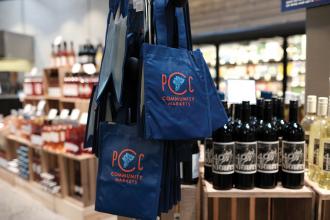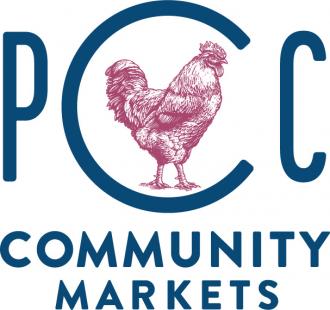What's in a Name?




On the morning of September 13, 2017, Seattle-based PCC Natural Markets (PCC), the nation’s largest food market co-op, surprised members, shoppers and the Pacific Northwest grocery industry. After nearly 20 years as PCC Natural Markets,* the 10-store co-op was dropping “natural” from its name to become PCC Community Markets and, with it, launch a new brand identity, website, and multi-faceted marketing campaign.
Just two weeks earlier, Amazon, also Seattle-based, completed its Whole Foods acquisition and reduced prices nationwide on a handful of items, promising further cuts to come. External observers might be quick to assume the PCC rebrand was the result of these recent industry changes.
In fact, nothing could be further from the truth. The brand initiative was a strategic project a year and a half in the making and a thoughtfully executed positioning of the co-op for the rapidly evolving future. At the heart of the project was cooperative principle five: education of members and public in cooperative principles.
Seattle is one of the fastest growing cities in the U.S. According to the U.S. Census Bureau, more than 1,000 people move to the area each week from around the country and the world to work at REI, Microsoft, Starbucks, Amazon, Boeing, and other companies. As a regional grocer, PCC and its values and co-op principles are unknown to many of these new shoppers.
There was also an underlying sense among the PCC leadership team that many Seattle shoppers didn’t understand what a food market co-op was, or why it was different from traditional grocery stores. For those who did understand what it was, leadership knew, anecdotally, that there were different perceptions of what it meant to shop at a food co-op. Depending on their prior experiences, some shoppers wondered if you had to be a member to shop, whether shoppers were required to work shifts in the store, and, whether members got different prices than non-member shoppers. (The answer to all of these is “no” at PCC.)
Finally, despite being a Seattle staple since 1953 (with its first public storefront in 1967), PCC with just 10 stores had only a fraction of the reach of a Kroger or Safeway, each with 40-plus stores in the Seattle area. How many shoppers even knew what a “PCC” was? [The initials PCC stand for Puget Consumers Co-op].
From discovery to execution
The co-op’s team agreed early that there was one primary goal of the brand project: to make it clear who PCC is and what it stands for. To accomplish this, the leadership team mapped out a multi-phased process that spanned 18 months:
1. Discovery: This included 60 hours of interviews with the PCC leadership team, PCC board of trustees, store directors, and staff; deep dives into past PCC research; synthesis of PCC history and milestones; and examination of third-party research to identify consumer trends and behaviors in the food and grocery categories.
2. Shopper and competitive research: Both qualitative and quantitative research was executed, including a brand awareness and brand equity study surveying 1,200 shoppers—both PCC and non-PCC shoppers to understand why they shop where they do and what matters most to them; and mapping out the values and attributes of competitors to see where PCC fits in the bigger picture. The goal of this phase was to understand the Seattle shopper, his/her awareness of PCC, and how the co-op was positioned within the Seattle grocery market.
3. Brand framework development: Using the information gathered in the first two phases and building on the PCC mission, the team developed foundational brand architecture. Things like brand purpose, positioning, and voice helped articulate, internally, who PCC is. This eventually informed creative development around the name, logo, colors, and voice, and amplified who PCC was externally.
4. Creative development: Informed by the first three stages, the creative team brought the co-op’s spirit to life visually—via graphics, photography, logo treatment, and more—as well as in written form. This provides a foundation for look, feel, voice, and tone, which comes to life through in-store messaging, marketing, and member communications.
5. Execution: Roll out slowly over weeks, or flip the switch in one night? The team decided to make the biggest impact by implementing a “hard launch” of the brand, switching out all old branded product over one night. Everything from napkins and cups to private label packaging and scale labels to aprons and nametags to in-store signage and website would bear the new logo and brand by morning. This transformation required tight orchestration across every corner of the co-op, including marketing, merchandising, operations, human resources, and IT.
Essential to each step of the initiative was engagement from the PCC board of trustees. In addition to participating in the discovery interviews, the board formed a brand task force made up of three board members. This group’s purpose was to ensure, through check-ins at key points in each phase, that the brand development process was thorough and that the resulting work aligned with the PCC mission.
Staff views – and the eyes of the shoppers
For any brand, company, or co-op, understanding the customer is the lynchpin to success. For PCC, the research it conducted early in the project played a vital role in shaping the direction of the brand work. Making decisions based on guesses, assumptions, and anecdotes could result in a brand that spoke only to current members or staff. Not listening to members and current staff could result in something that alienated the co-op’s core. Balance was critical.
During the internal listening and interviews, the team uncovered a couple big themes:
• Depending on whom you spoke to in the co-op, you would get a different story about what made PCC special. More than 1,400 staff members made for a lot of different stories—there wasn’t one consistent narrative about what made PCC unique.
• Staff whole-heartedly believed that PCC’s product standards, product quality, and relationships with local producers, ranchers, and farmers were an important strength.
These themes presented opportunities. First was to align the organization on one narrative to explain what makes PCC special, which was already at the core of the project. Another was to validate whether product standards, quality, and local relationships mattered to shoppers—and, if not, learn what did matter and how the co-op could “own” it.
To test out the themes and get a better understanding of its shoppers, PCC implemented a quantitative online questionnaire of 1,200 people in the Seattle area. The resulting data served to validate some of the internal takeaways, shake some perceptions about what mattered to shoppers, and shine a light on PCC’s broader recognition in Seattle. The most prescient takeaways included:
• About a dozen attributes drive 80 percent of the decision-making for where someone shops for groceries, including things like quality, prices, and proximity. Being a co-op fell to the bottom of the other 20 percent—after, among other attributes, company values and store hours.
• Only a quarter of non-members saw value in being part of a co-op, and another quarter didn’t know what a co-op was. The majority wasn’t sure if there was any value at all.
• When asked to name a grocery store that specializes in natural and organic foods, only 13 percent of non-PCC shoppers named PCC—the second lowest awareness in the Seattle market. However, those who did know PCC expressed strong positive feelings for it, exponentially stronger than for any other grocer in the market.
With the internal discovery and external research complete, the team started to sift through the data. Some things were easily addressed. Awareness could be tackled with an integrated marketing campaign. Other questions required more discussion.
Where did the co-op’s differentiators match what shoppers cared about? Things like quality, product standards, and knowledgeable staff instantly rose to the top—just as they had with the co-op staff. Where were the potential pitfalls, or “fool’s gold” of those topics that co-op leadership and staff found important, but shoppers indicated didn’t really matter when choosing a food market? And, the ultimate debate: Where did “co-op” fit in the narrative? Should it be part of the name, or a proof point in a larger story?
Community IS our middle name
Looking at the research, the team felt three pieces of data were potentially at odds when trying to answer whether to elevate “co-op” or not. On the one side, half of non-members saw no value in a grocer being a co-op. Supporting this notion was where “being a co-op” fell on the list of deciding factors for choosing a grocer: it was near the bottom. On the flip side, those shoppers who were members overwhelmingly understood the value of co-op and showed a love for PCC that matched consumers’ love for brands like Apple.
This brought the team back to Cooperative Principle Five. In a market where the majority of the competition is accountable to Wall Street or private equity investors, PCC strongly believed that being owned by the people was a meaningful differentiator. Perhaps it wasn’t a matter of simply declaring “We’re a co-op!,” but going one step further and educating shoppers about the benefits of a cooperative business model.
So, instead of leading with what it was (“co-op”), PCC led with why it mattered to be a co-op: community ownership with accountability to members only; relationships with local farmers, ranchers and producers; high standards and well-paid, knowledgeable staff; and a passion for cooking from scratch that can’t be matched by grocers more worried about their bottom line than the community they feed.
The co-op changed its name to PCC Community Markets to reflect its ownership and its commitment to the communities it serves. Marketing messaging proudly proclaims, “We aren’t just committed to our community—we’re owned by it.” Store signage, advertising, and the website celebrate the benefits, and differentiators, of being a co-op. Then, once shoppers are in the store or visit the co-op’s new website, the idea of becoming a member is introduced subtly: “There’s always room at our table. Come be a part of something bigger.”
As a result of this benefits-focused approach, after the mid-September launch the co-op’s membership rolls increased nearly 30 percent over the same period of the prior year; the website saw its highest day of traffic in co-op history; and transactions in the co-op’s 10 stores, a measure of new shoppers, grew between 5 and 10 percent. But, perhaps the greatest measure of success came from the positive member comments: “We love the name change! The way of the future is community, and we are excited that you’ve got your finger on this pulse.” •







